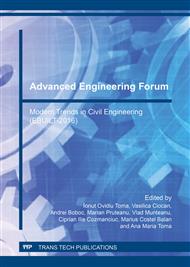[1]
Ehrlich H (1998) Geomicrobiology: its significance for geology. Earth Sci Rev 45(1– 2): 45–60.
Google Scholar
[2]
G.A. Kowalchuk, D.S. Buma, W. de Boer, P.G. Klinkhamer, J.A. van Veen, Effects of above-ground plant species composition and diversity on the diversity of soil-borne microorganisms, A. Van. Leeuw. J. Microb. 81(2002)509-520.
DOI: 10.1023/a:1020565523615
Google Scholar
[3]
J. Shi, Y. Suzuki, S. Nakai, M. Hosomi, Microbial degradation of estrogens using activated sludge and night soil-composting microorganisms, Water. Sci. Technol. 50(2004)153-159.
DOI: 10.2166/wst.2004.0510
Google Scholar
[4]
J.T. DeJong, B.M. Mortensen, B.C. Martinez, D.C. Nelson, Bio-mediated soil improvement, Ecol. Eng. 36(2010)197-210.
DOI: 10.1016/j.ecoleng.2008.12.029
Google Scholar
[5]
H.M. Jonkers, A. Thijssen, G. Muyzer, O. Copuroglu, E. Schlangen, Application of bacteria as self-healing agent for the development of sustainable concrete, Ecol. Eng. 36(2010)230-235.
DOI: 10.1016/j.ecoleng.2008.12.036
Google Scholar
[6]
N.W. Soon, L.M. Lee, T.C. Khun, H.S. Ling, Improvements in engineering properties of soils through microbial-induced calcite precipitation, KSCE. J. Civ. Eng. 17(2013)718-728.
DOI: 10.1007/s12205-013-0149-8
Google Scholar
[7]
J.K. Mitchell J.C. Santamarina, Biological considerations in geotechnical engineering, J. Geotech. Geoenviron. 131(2005)1222-1233.
DOI: 10.1061/(asce)1090-0241(2005)131:10(1222)
Google Scholar
[8]
W. De Muynck, N. De Belie, W. Verstraete, Microbial carbonate precipitation in construction materials: a review, Ecol. Eng. 36(2010)118-136.
DOI: 10.1016/j.ecoleng.2009.02.006
Google Scholar
[9]
P. Morgan, R.M. Atlas, Hydrocarbon degradation in soils and methods for soil biotreatment, Crit. Rev. Biotechnol. 8 (1989) 305-333.
Google Scholar
[10]
M.L. Dennis, J.P. Turner, Hydraulic conductivity of compacted soil treated with biofilm, J. Geotech. Geoenviron. 124(1998)120-127.
DOI: 10.1061/(asce)1090-0241(1998)124:2(120)
Google Scholar
[11]
J.T. DeJong, M.B. Fritzges, K. Nüsslein, Microbially induced cementation to control sand response to undrained shear, J. Geotech. Geoenviron. 132(2006)1381-1392.
DOI: 10.1061/(asce)1090-0241(2006)132:11(1381)
Google Scholar
[12]
Shashank, B. S., Sharma, S., Sowmya, S., Latha, R. A., Meenu, P. S., & Singh, D. N. (2016). State-of-the-art on geotechnical engineering perspective on bio-mediated processes. Environmental Earth Sciences, 75(3), 1-16.
DOI: 10.1007/s12665-015-5071-6
Google Scholar
[13]
S. Shreedhar, R.P. Devasya, K. Naregundi, CC. Young, AA. Bhagwath, Phosphate solubilizing uranium tolerant bacteria associated with monazite sand of a natural background radiation site in South-West coast of India, Ann. Microbiol. 64(2014).
DOI: 10.1007/s13213-014-0812-4
Google Scholar


